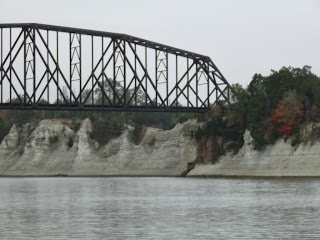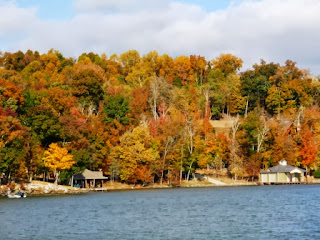We have traveled nearly 400 miles from our northern-most point on the Tennessee River back to Iuka, Mississippi. This is where we will leave the Tennessee River and begin traveling down the Tombigbee River to Mobile, Alabama. Mobile is our final destination for this year. We'll have the boat hauled out of the water there and stored on land until sometime next Spring. One reason to have the boat hauled is because next year we'll be back in salt water for the first time in four years. A boat in salt water needs anti-fouling paint on the hull, so we'll get the yard to apply the bottom paint while we are back home for the holidays.
The trip down the Tennessee has been much quicker than the trip up. First of all, the river current is flowing with us, so we are are traveling 1.5 - 2.0 knots per hour faster at the same engine speeds. Another reason for the speed down is the weather. The weather has been very changeable (I guess that is pretty much the definition of Fall, isn't it?) It seems that for every pleasant, sunny day we've had, there have been two overcast, cold days. One morning it was 25 degrees on the back deck when we woke up. Since I am the one who catches the bollard and rides on the deck as we go through the locks, I found these chilly days somewhat of a chore, especially since we always try to go through the locks in the morning if we can (to allow time to deal with unexpected delays if needed). The first shivering through a locking down resulted in a new hat and glove set for me. Actually, I had already made the fingerless gloves as a way to learn a new crochet technique, so I was able to whip up the hat using the left over yarn while we traveled between locks.
 |
| Warm wool boating accessories |
I realize that I mentioned the "catching the bollard" above, yet I may not have explained that in previous blog posts. The locks on these rivers are much higher than the locks on the Erie Canal or in Canada. There the locks have ropes hanging on the walls and you pick one or two up as you enter the lock, hook it to a cleat on your boat and and take it up (or let it out) as your boat goes up or down in the lock. But when the lock is 50 - 90 feet deep, taking up or letting out that much line simply isn't practical. So in these locks you pull up to a bollard, wrap one of your own lines around it, and it floats up or down with the boat as the lock fills or empties. But sometimes these bollards get hung up and stop rising or dropping with the water. If that happens your boat can be damaged quickly, so you don't get to tie the line to the bollard and then step back into the warm cockpit. You need to hold the line and be constantly prepared to let it go if a problem develops, which explains why I needed the hat and the gloves.
 |
| Lock floating bollard |
We did make a couple of stops on the trip down river to see things we hadn't seen on the way up. Jim's sister Melanie joined us for a few days of cruising, including a return to Florence, Alabama. Florence has the only Frank Lloyd Wright house built in the state of Alabama. When we first visited Florence, the house was closed, so we made it a point to schedule our return on a day the house would be open for touring.
 |
| Front of the house |
There is no question when you are driving around the neighborhood which house you are looking for, it is a classic Wright house. The back is a little less stark with a great wall of windows that overlooks the generously sized backyard.
The house was owned by one family for nearly 60 years. The money to build it was given to the couple as a wedding present by her parents in the early 1940s. They were newlyweds when they built it, but over time they had four sons, so it became the only Frank Lloyd Wright house for which Wright designed and built an addition. As is typical of an FLW house, he designed the furniture and even the lighting fixtures, much of which has been preserved. Every built in light in the house had this design. Apparently, each house he built had it's own light design.
 |
| Lighting detail |
 |
| Living room furniture designed by Wright |
Note the lovely turquoise furniture contrasting with the brown walls and floors. The "service area" (FLW-speak for kitchen) in the original house was a 4 ft x 4 ft cubby off of the dining room, so when she commissioned the addition, Mrs. Rosenbaum requested a more functional food preparation space. This is the stove she got when the addition was built in the 50s, a stove she used until the late 1990s when she finally left the home.
I would have coveted it if it had been gas, not electric.
The most amazing part of the Wright house story is how it came to be a tourist attraction in Florence, Alabama. By the time Mrs. Rosenbaum left the house, it was falling down around her. The city of Florence put a tax initiative on the ballot to increase the local sales tax to raise $600,000 to buy and re-hab the house. And the voters of Florence voted "yes". Can you imagine that happening today?
The other attraction we missed heading up river was the Apron Museum in Iuka, Mississippi. There are over 2,000 aprons in the collection, some dating from the civil war. There are men's aprons as well as women's aprons, although most of the collection is hand decorated "hostess aprons" from the 1950s.
 |
| Iuka, MS Apron Museum |
 |
| Samples of 1950s hostess aprons |
It is amazing to think of the time and attention to detail women spent on these things when they were stuck in the home during the 50s, with few outlets for their creative or artistic interests. As a needleworker myself, I was fascinated by craftsmanship of many of the pieces. The woman who owns the museum accepts donations and always tries to get stories from the women who make the donations about the history of the aprons and their family members who made them. She is not only collecting aprons, she is preserving the histories of women who would otherwise be forgotten. If you happen to be in Iuka, Mississippi, it is a fun stop.

















